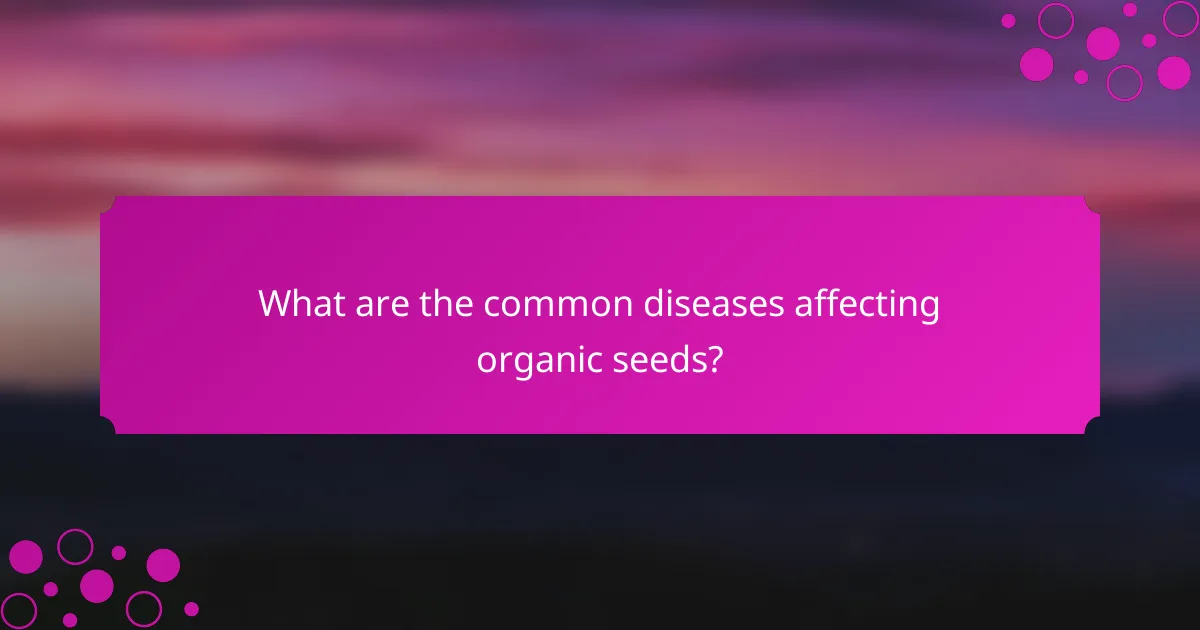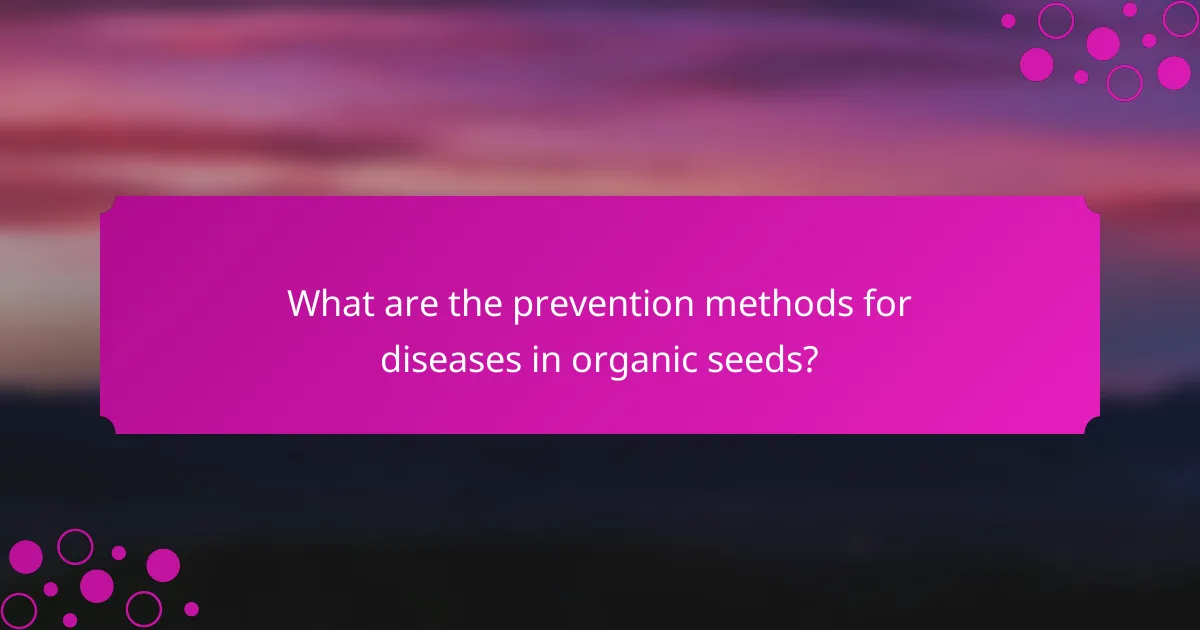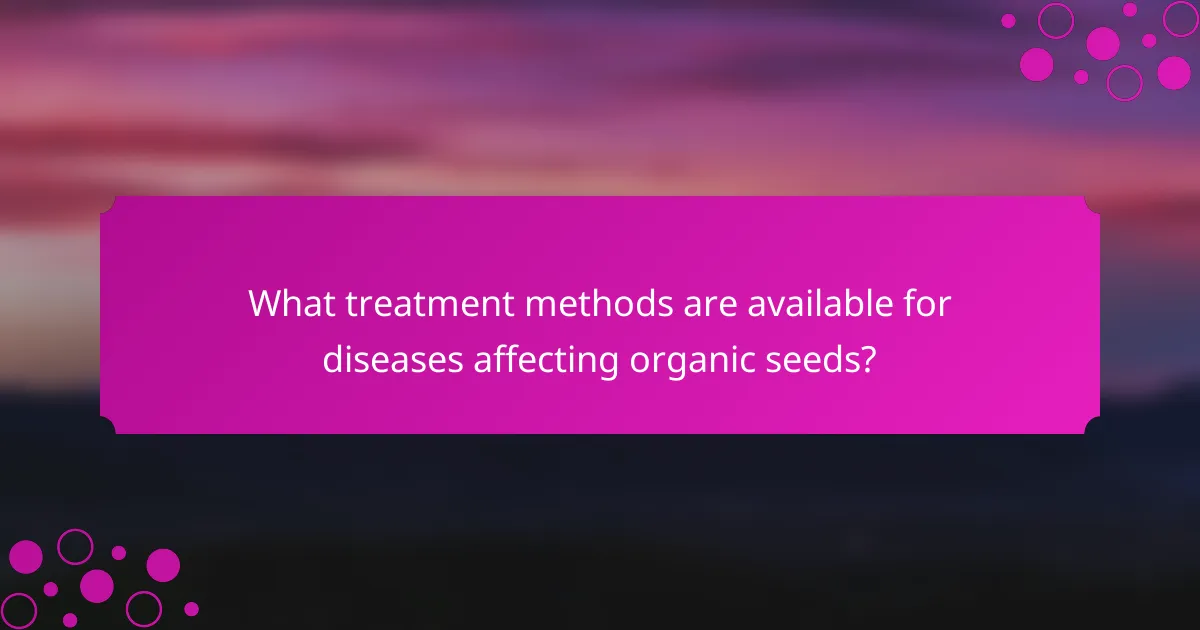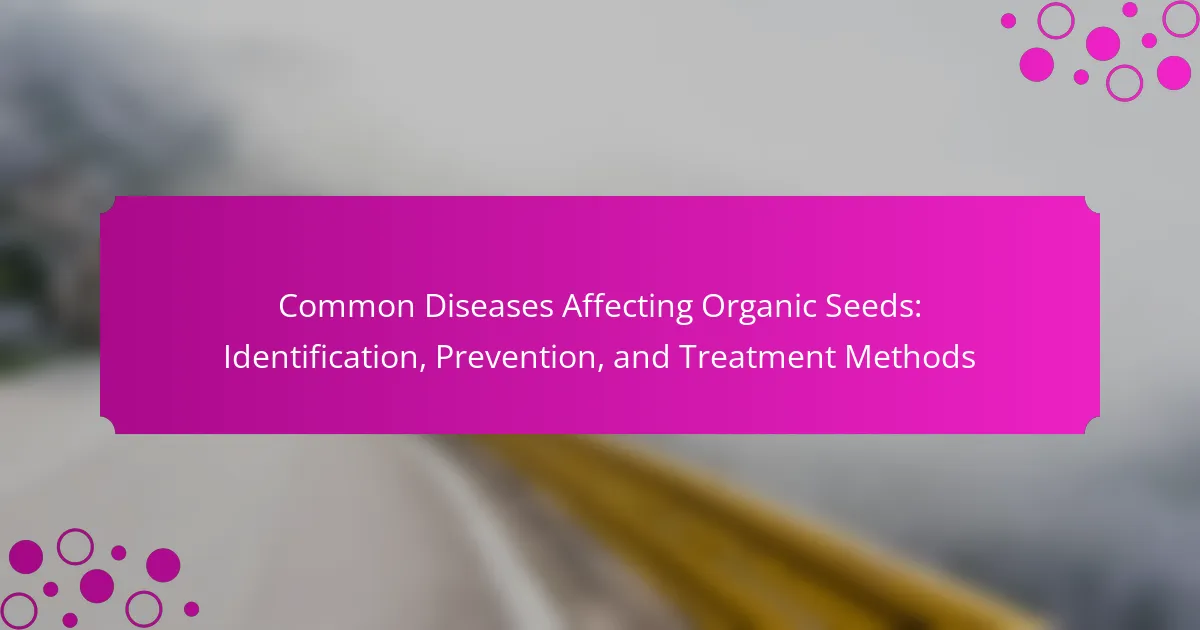Organic seeds are susceptible to various diseases, including damping-off, seed rot, and downy mildew. Damping-off, caused by soil-borne fungi, can lead to seedling death, while seed rot occurs due to excessive moisture, hindering germination. Downy mildew is a fungal disease that affects multiple crops and can diminish seed viability. Effective prevention methods include using disease-resistant varieties, practicing crop rotation, and maintaining soil health. Treatment options encompass biological control, resistant varieties, and organic-approved fungicides, all aimed at enhancing seed resilience and ensuring better crop yields. This article provides a comprehensive overview of these common diseases, their prevention, and treatment strategies in organic seed production.

What are the common diseases affecting organic seeds?
Common diseases affecting organic seeds include damping-off, seed rot, and downy mildew. Damping-off is caused by soil-borne fungi and leads to seedling death. Seed rot occurs due to excessive moisture and can prevent germination. Downy mildew is a fungal disease that affects various crops and can reduce seed viability. These diseases can significantly impact crop yields and quality. Proper seed handling and storage can help mitigate these issues.
How can these diseases be identified?
Diseases affecting organic seeds can be identified through visual inspection and laboratory testing. Visual symptoms include discoloration, wilting, or unusual growth patterns on the seeds or plants. Laboratory testing can confirm the presence of pathogens, such as fungi or bacteria, through culture methods or molecular techniques. For example, the presence of Fusarium species may be identified by observing characteristic lesions on seeds. Accurate identification is crucial for effective management and treatment of these diseases.
What symptoms indicate the presence of specific diseases?
Symptoms indicating the presence of specific diseases in organic seeds include discoloration, wilting, and stunted growth. Discoloration can manifest as yellowing or browning of leaves, indicating potential fungal infections or nutrient deficiencies. Wilting often signifies root rot or water stress due to pathogens. Stunted growth may be linked to viral infections or soil-borne diseases. Additionally, the presence of mold or unusual spots on seeds can indicate fungal diseases. These symptoms help in early identification and management of diseases affecting organic seeds.
How do environmental factors influence disease identification?
Environmental factors significantly influence disease identification in organic seeds. These factors include soil quality, moisture levels, temperature, and sunlight exposure. Variations in these conditions can affect the prevalence and visibility of diseases. For instance, high humidity can promote fungal infections, making them easier to identify. Conversely, dry conditions may mask symptoms of certain diseases. Soil composition can also influence nutrient availability, which affects plant health and susceptibility to diseases. Research shows that specific environmental stressors can lead to increased disease incidence. Understanding these factors aids in early detection and management of diseases in organic agriculture.
Why is it important to understand these diseases?
Understanding these diseases is crucial for maintaining healthy organic crops. Knowledge of diseases allows for early identification and effective management. This can significantly reduce crop loss and improve yield. Research indicates that informed farmers can reduce disease incidence by up to 50%. Understanding disease cycles aids in implementing preventive measures. It also facilitates the selection of resistant seed varieties. Educated growers can make better decisions about crop rotation and soil health. Overall, awareness leads to sustainable farming practices and food security.
What impact do these diseases have on crop yield?
Diseases can significantly reduce crop yield. They affect plants by causing stunted growth, wilting, and premature death. For instance, fungal infections can lead to the rotting of roots and stems. Bacterial diseases often result in leaf spots and blights. Viral infections can cause deformities and reduced photosynthesis. The USDA reports that plant diseases can cause yield losses of 10-30% in various crops. Severe outbreaks may result in losses exceeding 50%. Effective disease management is crucial to minimize these impacts.
How do diseases affect the overall health of organic farming systems?
Diseases negatively impact the overall health of organic farming systems. They can reduce crop yields and affect plant vitality. Infected plants may exhibit stunted growth and poor fruit development. Disease outbreaks can lead to increased pest populations, compounding the problem. Soil health can also decline due to pathogen presence. Organic farming relies on biodiversity, and diseases can disrupt this balance. Effective disease management is crucial for maintaining soil fertility and crop resilience. Research indicates that integrated pest management can mitigate these effects and promote healthier farming systems.

What are the prevention methods for diseases in organic seeds?
Prevention methods for diseases in organic seeds include using disease-resistant varieties, practicing crop rotation, and maintaining soil health. Disease-resistant varieties are bred to withstand specific pathogens, reducing the likelihood of disease outbreaks. Crop rotation disrupts the life cycles of pests and pathogens, minimizing their impact on subsequent crops. Maintaining soil health through organic amendments enhances plant vigor, making them less susceptible to diseases. Additionally, proper seed storage and sanitation practices help prevent disease spread. Regular monitoring for early signs of disease allows for timely intervention. These methods collectively contribute to healthier organic seed production, ensuring better yields.
How can seed selection contribute to disease prevention?
Seed selection can significantly contribute to disease prevention by ensuring the use of disease-resistant varieties. Selecting seeds that are bred for resistance can reduce the incidence of specific pathogens. For example, certain tomato varieties are developed to resist blight. This selection process minimizes the need for chemical treatments, promoting organic practices. Additionally, seeds selected for local adaptability can thrive in specific environmental conditions, further reducing stress and vulnerability to diseases. Research shows that healthy seeds lead to stronger plants, which are less susceptible to infections. Therefore, proper seed selection is a key strategy in disease management for organic farming.
What traits should be considered when selecting seeds?
When selecting seeds, consider traits such as disease resistance, germination rate, and adaptability. Disease resistance helps ensure plants can withstand common pathogens. Germination rate indicates the percentage of seeds that sprout successfully. Adaptability refers to how well seeds perform in specific environmental conditions. Other traits include growth habit and yield potential. Growth habit affects space and resource requirements. Yield potential indicates the expected harvest quantity. Selecting seeds with these traits enhances overall plant health and productivity.
How does crop rotation play a role in disease prevention?
Crop rotation plays a significant role in disease prevention by disrupting the life cycles of pathogens. Different crops can harbor specific diseases. When crops are rotated, pathogens associated with a previous crop are less likely to survive. This reduces the incidence of soil-borne diseases. For example, rotating legumes with cereals can lower the risk of root diseases. Research shows that implementing crop rotation can decrease disease prevalence by up to 50%. This method promotes soil health and biodiversity, further enhancing disease resistance.
What cultural practices can reduce disease risk?
Cultural practices that can reduce disease risk include crop rotation, proper sanitation, and the use of resistant varieties. Crop rotation disrupts the life cycles of pathogens and pests. It helps maintain soil health and reduces disease incidence. Proper sanitation involves cleaning tools and removing debris to minimize disease spread. This practice is crucial in preventing contamination. Using resistant varieties can significantly decrease the likelihood of disease outbreaks. Research shows that integrated practices can lead to healthier crops and lower disease prevalence. For example, studies indicate that crop rotation can reduce specific diseases by up to 50%.
How does soil health influence disease resistance?
Soil health significantly influences disease resistance in plants. Healthy soil promotes robust root systems. Strong roots enhance nutrient uptake and water retention. This leads to vigorous plant growth, making plants more resilient to diseases. Healthy soil also fosters beneficial microorganisms. These microorganisms can outcompete or suppress harmful pathogens. Research indicates that diverse soil microbiomes improve plant health and disease resistance. For example, a study by van Elsas et al. (2012) found that healthy soils support microbial diversity, which correlates with reduced plant disease incidence. Thus, maintaining soil health is crucial for enhancing disease resistance in crops.
What role does sanitation play in preventing seed diseases?
Sanitation is crucial in preventing seed diseases. It minimizes the presence of pathogens that can infect seeds. Regular cleaning of tools, equipment, and storage areas reduces disease transmission. Proper disposal of plant debris also limits pathogen survival. Research indicates that maintaining clean environments can decrease disease incidence significantly. For example, studies show that sanitized seed storage can lower fungal infections by up to 70%. Implementing sanitation protocols is a proactive approach to safeguarding seed health.

What treatment methods are available for diseases affecting organic seeds?
Treatment methods for diseases affecting organic seeds include biological control, crop rotation, and the use of resistant varieties. Biological control involves utilizing natural predators or pathogens to manage disease. Crop rotation disrupts disease cycles by alternating crops, reducing pathogen buildup. Resistant varieties are bred to withstand specific diseases, minimizing loss. Additionally, proper seed treatment with organic-approved fungicides can prevent disease onset. Maintaining soil health through organic amendments can also enhance seed resilience. These methods are supported by research indicating their effectiveness in managing seed diseases while adhering to organic standards.
How can biological treatments be utilized?
Biological treatments can be utilized to manage diseases affecting organic seeds. These treatments involve using natural organisms or substances to enhance plant health. Beneficial microbes, such as bacteria and fungi, can suppress pathogens in the soil. For instance, Trichoderma species are known to combat root rot diseases effectively. Additionally, biological pesticides derived from natural sources can target specific pests without harming beneficial insects. Research indicates that these methods can improve crop resilience and yield. Studies show that integrating biological treatments into farming practices can reduce chemical inputs and promote sustainable agriculture.
What are the benefits of using beneficial microbes?
Beneficial microbes enhance soil health and plant growth. They improve nutrient availability and uptake in plants. Beneficial microbes can suppress soil-borne pathogens, reducing disease incidence. They also promote root development, leading to stronger plants. Research shows that beneficial microbes can increase crop yields. For instance, a study by Zhang et al. (2020) found a 20% yield increase in crops treated with beneficial microbes. Additionally, they help in nitrogen fixation, which is crucial for plant nutrition. Overall, the use of beneficial microbes supports sustainable agriculture practices.
How do organic fungicides work against seed diseases?
Organic fungicides work against seed diseases by inhibiting fungal growth and preventing infection. They contain natural ingredients that disrupt the life cycle of pathogens. Common active components include plant extracts, beneficial microorganisms, and minerals. These substances can enhance plant resistance and promote healthy root development. Studies show that organic fungicides can reduce disease incidence by up to 70%. They are effective in controlling common seed diseases like damping-off and seed rot. By creating an unfavorable environment for pathogens, organic fungicides protect seed integrity and promote germination.
What are some common chemical treatments for organic seeds?
Common chemical treatments for organic seeds include fungicides, insecticides, and seed coatings. Fungicides help prevent fungal diseases that can affect seed germination and plant health. Insecticides protect seeds from pests that may damage them before or after planting. Seed coatings often contain beneficial microorganisms or nutrients that enhance seed performance. These treatments are used in compliance with organic farming standards to ensure minimal impact on the environment. Research shows that effective seed treatment can lead to improved crop yields and healthier plants.
What regulations govern the use of chemicals in organic farming?
Regulations governing the use of chemicals in organic farming are primarily defined by the USDA National Organic Program (NOP). The NOP prohibits the use of synthetic chemicals in organic farming. Organic farmers must use natural substances and approved non-synthetic alternatives. The regulations also require that any substances used must be on the National List of Allowed and Prohibited Substances. This list includes specific natural pesticides and fertilizers. Compliance with these regulations is enforced through regular inspections and certification processes. Violations can result in loss of organic certification. These regulations ensure that organic farming practices maintain environmental sustainability and consumer health.
How can chemical treatments be applied safely?
Chemical treatments can be applied safely by following specific guidelines. First, always read and understand the label instructions. This includes dosage, application method, and safety precautions. Wear appropriate protective gear such as gloves, masks, and goggles during application. Apply treatments during calm weather to prevent drift and avoid applying before rain. Ensure proper ventilation in enclosed areas to minimize inhalation risks. Store chemicals in their original containers and out of reach of children and pets. Dispose of any unused chemicals according to local regulations. These practices reduce the risk of harm to both the applicator and the environment.
What are the best practices for managing diseases in organic seeds?
Best practices for managing diseases in organic seeds include selecting disease-resistant varieties and practicing crop rotation. Disease-resistant seeds reduce the risk of infection. Crop rotation disrupts disease cycles and enhances soil health. Proper sanitation of tools and equipment prevents disease spread. Additionally, maintaining optimal growing conditions minimizes stress on plants. Regular monitoring for early signs of disease allows for timely intervention. Implementing organic pest management strategies further protects seed health. These practices collectively enhance the resilience of organic seeds against diseases.
How can farmers monitor seed health effectively?
Farmers can monitor seed health effectively by utilizing visual inspections and laboratory testing. Regular visual inspections allow farmers to identify signs of disease, such as discoloration or mold. Laboratory testing can provide precise information about seed viability and pathogen presence. Tools like seed germination tests help assess the seed’s ability to sprout. Additionally, farmers can employ moisture meters to ensure seeds are stored at optimal humidity levels. Monitoring temperature and light conditions also contributes to seed health. Research indicates that maintaining proper storage conditions can reduce seed deterioration by up to 30%. These methods collectively enhance the monitoring of seed health.
What steps should be taken after disease identification to mitigate damage?
After disease identification, immediate action should be taken to mitigate damage. First, remove and destroy infected plants to prevent the spread of disease. Next, assess the remaining plants for signs of infection. Implement proper sanitation practices to eliminate pathogens from tools and surfaces. Adjust environmental conditions to reduce humidity and improve air circulation. Apply appropriate fungicides or treatments as recommended for the specific disease. Monitor the plants closely for any recurring symptoms. Lastly, document the disease occurrence and treatment measures for future reference. These steps are crucial for maintaining plant health and ensuring crop yield.
Common diseases affecting organic seeds include damping-off, seed rot, and downy mildew, which can significantly impact crop yields and quality. The article outlines methods for identifying these diseases through visual symptoms and laboratory testing, emphasizing the importance of early detection. It discusses prevention strategies such as selecting disease-resistant varieties, practicing crop rotation, and maintaining soil health. Furthermore, treatment methods, including biological control and organic fungicides, are explored to manage these diseases effectively. Understanding these aspects is crucial for sustainable organic farming and ensuring healthy crop production.
